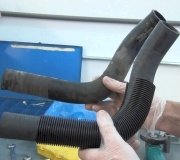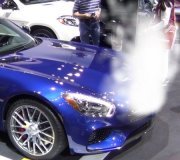The easiest way to do this: While engine is cold
Remove the radiator cap that's located on top of the overflow container. Start the engine and turn heat on high and let the engine warm up to operating temps. When the radiator fans come on and/or both the upper and lower radiator hoses are hot to the touch, squeeze the upper radiator hose several times while watching for bubbles in the overflow tank. You may want to use gloves to squeeze the hose, and make sure the temp gauge doesn't go over the half way mark. If it does, shut the engine off.
Repeat this until there's no more bubbles in the system. Next check both the smaller hoses coming out of the firewall (heater core). They should both be hot. If you're sure you got all the air out of the system, then the heater control valve isn't working. That will be next.
Monday, February 7th, 2011 AT 12:55 PM




